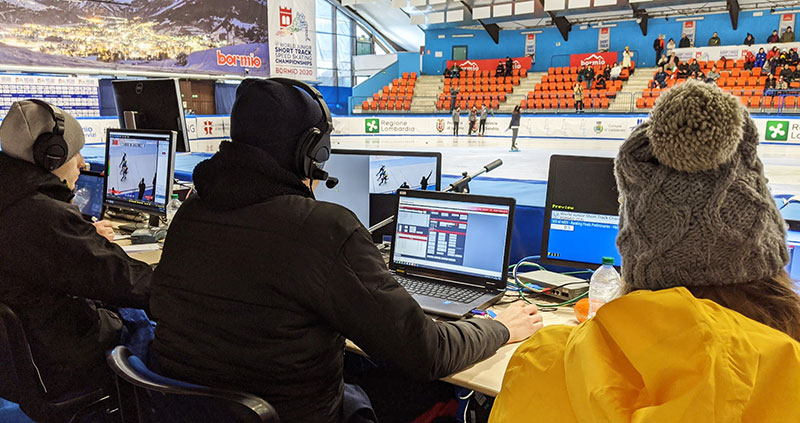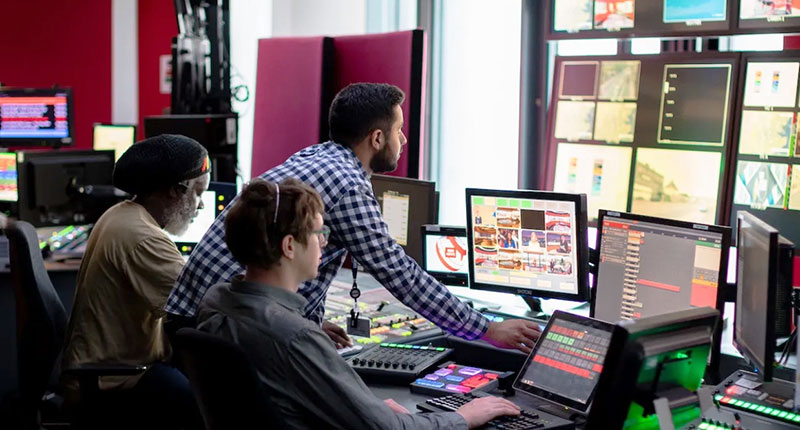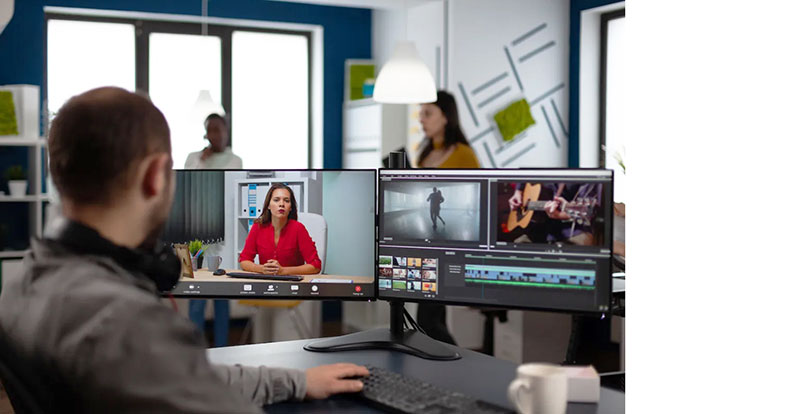Miguel Coutinho at NDI talks about the development of one of the most widely used VoIP network protocols in the video industry today and its expansion into new uses and industries.

Network Device Interface (NDI) is one of the most widely used video-over-IP-network protocols in the broadcast and video production and distribution industries today. Its applications as a connectivity tool for video are expanding beyond broadcast and Pro AV to support cloud production, content creation, streaming and others for surveillance, corporate, healthcare and education clients.
According to NDI, more than 550 SKUs (Stock Keeping Units), 200-plus software applications and over 600 thousand devices use NDI for connectivity features including discovery, registration, video, audio, metadata and control.
Using a new kind of network application layer, NDI simplifies the building of systems as well as the transmission and call of various signals within systems, resulting in simpler, more flexible system design, integration, application and maintenance. With simplicity comes a reduction in costs as well. As TV and video production studios shift from hardware to software-based operations, the smaller number of people and devices required on site controls the cost of most types of production.
Miguel Coutinho, Head of Strategy at NDI, talked to Digital Media World about what the team has been working toward since the protocol’s release in 2016 – specifically, NDI’s expansion into more varied industries and how to facilitate that trend into the future.
More Industries, More Connected
As the use of video has expanded across industries, so has the importance of universal, agile connectivity. “Looking at specific segments, in the last couple of years we have seen NDI extend beyond traditional broadcast,” Miguel said. “It has moved into uses like conferencing, where multi-camera rooms are becoming the norm, large-scale AV installations where the ability to scale inputs and outputs easily is essential, and prosumer content creation where we see more multi-device setups.”
Any situation where two or more multimedia systems need to connect to share video, audio or just metadata, for example for remote control, can benefit – either two hardware devices, two software programs, or a combination. NDI’s goal is an ecosystem in which these systems can connect instantly, requiring as little work as possible from users, no matter how complex the environment.

“Of course, that’s not always possible right now, but with every release, we are pushing this plug & play experience to more and more use cases,” said Miguel. “That focus started with local networks back in 2016 when NDI was released, but the same can be said of connections over the internet today, using the free NDI Bridge tool that shares NDI sources with others beyond the local network. Our upcoming release, NDI 6, will continue the trend as we bring the capabilities of NDI Bridge closer to our core technological stack.”
Adapting and Optimising with NDI
Furthermore, Miguel noted that the difference between building software or a device from the start with NDI support, and adding it later, is not significant. “Both types of companies are coming to us. Some of them are defining the requirements for a device and want to understand how to add NDI before shipping the devices. Others license the technology and make it available to users through free software updates. What we are noticing, though, is that users are starting to value and demand devices where extensive NDI support is guaranteed.
Video operators are regularly faced with the need to optimise between compression and bandwidth depending on their application, which NDI addresses by developing two main formats. Miguel said, “NDI High Bandwidth uses SpeedHQ, a proprietary codec that delivers the least amount of compression in the NDI ecosystem, at the expense of higher bandwidth consumption. NDI HX, now in its latest version HX3, is built around the AVC and HEVC codecs and results in higher compression, but its lower bandwidth requirements make it more flexible and useful mostly for applications other than broadcast.
“We continuously assess whether these two options cover all use cases we support today because, as NDI is deployed more widely, new formats and different compression levels may be needed. But we will always make that decision from users’ point of view.”

Going Wide
Seeking other ways NDI could be developed to serve a wider range of applications, the company regularly engages with users, existing and potential new licensees, system integrators and other partners to discover new requirements. “By getting inputs both from existing users who want to expand its usage, and those looking to adopt NDI for the first time, we access a broad view on what the common needs are, and what to develop towards.”
In particular, they are looking either for places where complexity reigns and NDI has an opportunity to significantly improve the current workflow; or for new places that NDI is stretching toward; or finally, for places where it is already in use but where scope exists for further integration into workflows.
Miguel said, “The main challenge is always matching the specific needs we identify with the scalability and interoperability requirements needed to keep our promise intact. Setting priorities is also a challenge, as we target more and more segments of the multimedia world. Our close partners, who also want to see NDI deployed in as many spaces as possible, also help us quite a lot in this respect.”
NDI can alleviate the need for additional encoding, decoding and associated equipment. “If you have two things that speak NDI, you can avoid adding a step or device in the middle to encode and decode NDI into something else, and then back again,” Miguel mentioned. “You also won’t need specialized knowledge on how to connect different AV products to each other. As long as the devices are on the same network, and are the right products, they become automatically discoverable and work together.”
Navigating Innovation – Certification
NDI operates a Certification program recognising the fact that two kinds of multimedia products exist in the NDI ecosystem. “First are the products that take advantage of our technology by integrating one of our SDKs. Second are products that are compatible with NDI, but do not use our technology. We have two certification programs that address these two groups – the NDI Certified program and the Works with NDI program.

The first group, NDI Certified, includes multimedia products like cameras, displays, video switchers, desktop apps and many others that license the SDK in the NDI Advanced level of connectivity. This SDK comes custom-packaged for software or hardware – CPU, GPU and FPGA – with all connection settings personalised as far as possible, and the products become automatically eligible for the NDI Certified program. “Here, we want users to rest assured that the NDI-enabled product they are purchasing for a critical part of their workflow won’t fail and will perform to the highest standards of interoperability and quality,” said Miguel.
“The second group, Works With NDI, typically includes such products as network switches or desktop plug-ins that don’t need the SDK or make little use of our technology. Example applications are an NDI-enabled remote controller that only uses the metadata layer, or a switcher that delivers NDI compatible profiles. We can still test it and guarantee that it offers configurations that are sure to optimize its usability and performance within an NDI-based workflow.”
Core Metrics
He described their optimisation process around three core metrics. First is interoperability – are systems going to be compatible? Second, plug & play – how easy will it be to use NDI on these systems? - and finally efficiency – are they doing the job without adding unnecessary strain on the system? “Our focus on interoperability means that some features take a bit longer before they are deployed into our ecosystem,” he said. “But we have always found ways to make it work when we believe a new feature adds value.”
NDI’s support and R&D teams test interoperability according to objective criteria, divided between two primary camps – technical (for instance, are discovery and registration performing at the right level?) and functional, such as, can the user share an NDI stream from this device using the fewest steps possible?
Although NDI defines these and commits to keeping them stable over time, they are informed by what they see in the ecosystem, in particular from continuous observation of how users are deploying NDI. In this way, they can ensure that when new features are introduced, they also update certification criteria to match changing expectations.
The Next Goal

Obviously, many NDI-enabled products are yet to be tested and certified, and some of them work very well. After all, one of NDI’s strengths for developers is how easy it is to integrate into new products.
However, although the goal is for all of them to work cohesively, in reality, NDI’s end users and licensees do face some challenges and the expanding range of enabled devices and applications naturally introduces more complexity. Miguel said, “A product’s functionality may well be prioritised over compatibility. What certification gives is a guarantee for those users who aren’t willing to risk the performance and quality of their setups.” ndi.video




